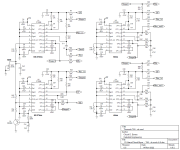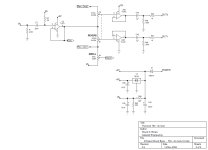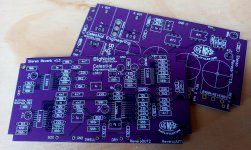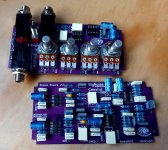Chuck D. Bones
Circuit Wizard
I took a break from working on the BBD reverb to explore the possibilities an improved version of the Belton Brick. I came across Brian Thornock's T60 reverb and that looked like a good place to start. Check out his website, he has a few reverb projects there. The T60 uses four, count 'em, four PT2399s. The T60 is based on the Belton design, but goes much further in the quest to build a realistic sounding reverb. One of the features of the T60 is a SIZE control that varies the delay in two of the four PT2399 so the user can vary the size of the "room" in which reverberation takes place. The T60 also has a MIX control and a DWELL (feedback) control. To keep the delay from sounding sterile, Brian used two LFOs running at different speeds to modulate the clocks in the two longest delay chips. Very effective and unlike the Belton, it doesn't sound cyclic. In another of his reverb designs, he uses the envelope to modulate the clock and that works even better. Turns out that pins 7 and 8 on the PT2399 have signals on them that follow the envelope of the signal passing thru the chip. Brian's schematic was hard for me to read, so I redrew it and made mods from there. I fiddled the resistor values a bit, changed a couple of connections and wired it for mono-in, stereo-out (similar to the Belton's two outputs). Even my cleaned-up schematic is hard to digest because there are so many signal paths. The guitar signal comes in and is mixed with the feedback (DWELL) signal and then sent out to all four PT2399s. Like the Belton design, the outputs of all four chips are mixed together and sent back out out to all four chips. All four chips have local feedback as well. Basically, each delay chip has three inputs: the dry input signal, local feedback from itself and global feedback from all four chips. All of these paths create dozens of reflections. Each chip has a different delay ranging from 48ms to almost 400ms when the SIZE control is dimed. The REVERB (blend) control goes from 100% dry to 100% wet. When the DWELL control is dimed, the thing breaks into self-oscillation. I didn't have a B100K dual pot for the REVERB control, so the breadboard has two blend controls, one for the Left channel and one for the Right. The white box on the left is my stereo headphones amp. Controls from L to R are Left REVERB, Right REVERB, DWELL and SIZE. Brian used a dual pot to vary the clocks on two chips. I found that it can be done with a single pot. The four PT2399s are in the top row, with the output mixer / buffer at the far right. Below that is the 5V regulator. The input buffer is at the bottom right. This is the cleaned-up layout and it is still quite the spaghetti factory.
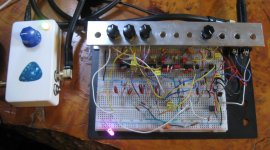

Last edited:


